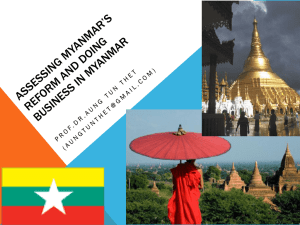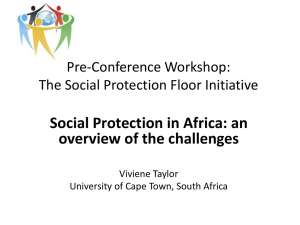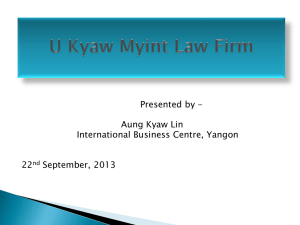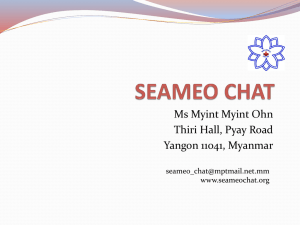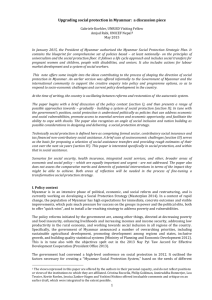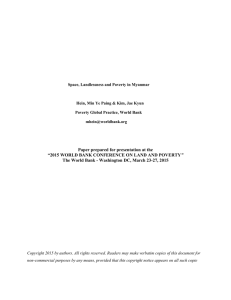Foreign Aid Effectiveness Management - UN
advertisement
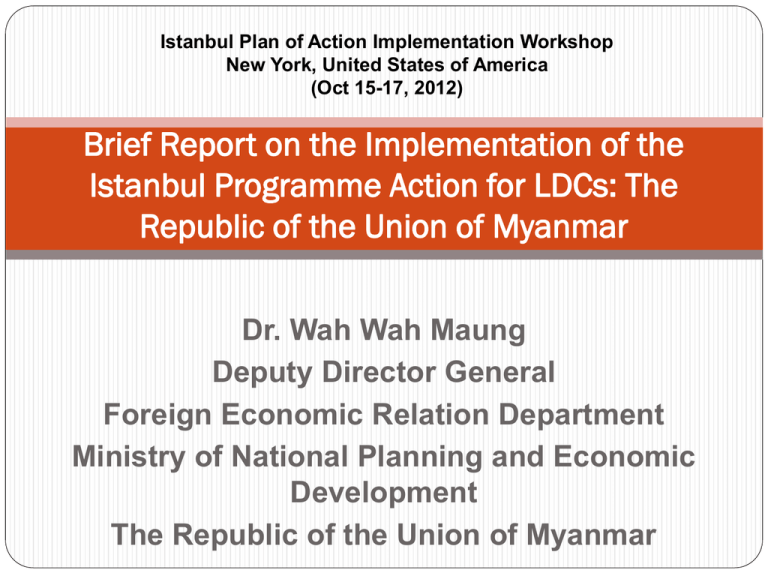
Istanbul Plan of Action Implementation Workshop New York, United States of America (Oct 15-17, 2012) Brief Report on the Implementation of the Istanbul Programme Action for LDCs: The Republic of the Union of Myanmar Dr. Wah Wah Maung Deputy Director General Foreign Economic Relation Department Ministry of National Planning and Economic Development The Republic of the Union of Myanmar Changing Era All aspects of reforms: Political, economic, social, institutional Practicing elements of Democratic System According the speeches of the President Good Governance Transparency Anti-corruption Check and Balance Utilizing Public Finance effectively and efficiently A series of political and economic reforms political dialogue with Daw Aung San Su Kyi, free and fair bi -election, release of prisoners, developing civil society in Myanmar, free discussion at the parliamentary meeting, invitation of the exiles back to our country, policy consultation with multi stakeholders for the national development, A series of political and economic reforms promoting freedom of journalism and its associations, peace peace talks with ethnic armed groups implementing national level projects of rural development and poverty reduction conducting macroeconomic reforms First Stage of Reform Process Focus more on political reforms: Peace Talk, Bi election, Release of prisoners Focusing on good governance, Clean government Institutional reforms Second Stage of Economic Reform Second Stage Economic Reform • Focusing more on Economic and Administrative Reforms • Rule of Law • Close cooperation, coordination and collaboration among the ministries, regional and local governments Our Vision actively engaged in building a new, modern, developed and democratic nation necessary to strengthen systematic market economic system to accelerate the pace of economic development getting out of poverty trap Our economic policies Sustaining Agriculture towards Industrialization and All round Development Balance and proportionate development among States and Regions Inclusive growth for entire population correctness of statistics and statistical systems Changing planning system We have changed out from centralized to decentralized one. Regional plans are formulated by regional and local governments Our ministry is also finalizing 5 years Plan (from 2011-12 to 2015-16) also planning to draw National Comprehensive Development Plan ( NDCP- 2011-2030) National Planning Plans and projects proposed by Ministries • Sectoral Plan Plans and projects proposed by State and Regional Governments • Regional Plan For the formulation of National Development Plan National • Organizing Regional Workshops in States and Regions • Public Consultation for their Development Plan needs and inputs for the plan formulation • National level workshop will be organized after all regional level workshops have been convened. Future National Plans 2 Annual Plans already approved by the parliament • 2011-12 Annual Plan and 2012-13 Annual Plan Now, our ministry is formulating 5 years national plan, expect to submit next parliamentary session • 5 years national plan ( 2011-12 to 2015-16) Comprehensive National Development Plan (Long term development plan) We also have a plan for long term development. • With long term national vision 20 years or 30 years National Plan • Duration: 2011 -2030 Quick wins for short term But, quick wins are also important. Poverty intended to reduce 2 % per year Short term therapy ? Matching short term plan/ program of donors as well as project duration and type of support with our priority areas and regions Sustaining Agriculture towards Industrialization and All round Development Since our economy is based on agriculture sector, it is necessary to maintain for the momentum of agriculture to fulfill world food security Sharing our agricultural products to the global community. Moreover, it will also provide national food security as well as for the rural development and poverty reduction Since 70 % of our population residing in the rural area and 50 percent of the people are engaging in those agricultural activities. Apart from that, according to the development experiences of different countries, it cannot be developed without industrialization process. That is why we are establishing Special Economic Zones for promoting industrial sector. Focusing balanced and equitable growth Since our country is a Union Nation, it is necessary to focus balanced and equitable growth among the states and regions. development paradigm has already shifted we need to focus human development to improve the quality of life inclusive growth for entire population to realize people-centered development Human development index of Myanmar Quality data Correct ing our statistical system for ensuring quality data which reflect the real situation. National census in 2014 To implement all those policies, it is necessary to nurture human resources and establish education process To create new institutions, use new technologies, cope with their environment, and alter their patterns of behaviour We need an education system that improves the capabilities of individuals and capacity of institutions. Trade and Investment as the engine of growth Business laws, rules and regulations for the company registration are being amended and improve for the faster processes. Some laws, rules and regulations are to be amended and some laws will be enacted Foreign Direct investment Law amended Revised Foreign Investment Law and it will create more economic opportunities and business friendly environment. Special Economic Zone Law, Dawei SEZ Law Necessary law such as Competition Law, Consumers Protection Law are also under process. Stakeholders for Development Government Public International Organization ( IO)/ International Nongovernmental Organization ( INGOS) Private sector Non Governmental Organization, Civil Society Organization Trade and investment policies reforms Changes in trade and foreign exchange policies were aimed at transforming the economy from a state sector dominated socialist economic system to a market-oriented economic system. The role of the private sector in external trade was expanded sharply. Border trade expended. Import, export licensing and Company registration procedures are eased Banking Sector Interest rate Taxation policies Managed float: Exchange rate Banking sector reforms: More private banks, more financial services are allowed Technical Assistance: IMF, WB Capital Market Development: Daiwa Exports, Imports and Duties Sr. Particular 2011-2012 ( Million kyat) 2012-2013 (April-June) ( Million kyat) 1. Domestic Export 8266.2 2081.6 2. All Export ( including re-export) 9135.6 2223.4 3. Import 8325.6 1901.9 4. All Import ( includes draw-back items) 14130.1 6635.3 5. Custom Duties ( Normal Trade) 115372.4 79368.0 6. Custom Duties ( Border Trade) 14130.1 6635.3 7. Custom Duties (All) 129502.5 86003.3 Investment A total of 456 foreign enterprises in 12 sectors from 31 countries were permitted with the total pledge amount of USD 40424.07 million up to 2012, March. China is the 1st leading investor Thailand and Hong Kong are taking place in 2nd and 3rd respectively. power sector - 40.30%, oil & gas sector- 38.31 % mining sector- 7.75% Program for the Poverty Reduction To achieve the MDGs Institutional mechanism for eight tasks (a) Development of agricultural production sector (b) Development of Livestock sector (c) Development of rural productivity and cottage industries (d) Development of micro saving and credit enterprises (e) Development of rural cooperative tasks (f) Development of rural socio-economy (g) Development of rural energy (h) Environmental conservation. Reducing the half of poverty line in 2015. We have set our target to reduce the half of poverty line in 2015. Currently it is now 26% is below the poverty line trying to reduce until 16 % in 2015. In that case, we need more cooperation not only from regional community but also from global community. Aid Effectiveness Aid effectiveness is also emphasized after the openness of our economy. Since our international relation has been improved, we received more aid, grants from the donors community. We also would like to build the trust with international community as well as we ourselves would like to have aid effectiveness for our national aim of poverty reduction. Sources of Finance: Consideration for the best allocation of the sources of finance Own Budget Foreign Direct Investment Source of Finance Aid Grant Loan Sources of finance Grant Aid Loan Foreign Aid Effectiveness Paris Declaration on Aid Effectiveness Ownership Mutual accountability Managing for results Alignment Harmonization Aid Effectiveness Mechanism Now we have already formed Central Committee on Aid effectiveness chaired by the President. Under the Central committee, we have working committee as well as National Socio-economic Advisory Council (NSAC) which comprises Academicians, private sectors and civil society. Matching between Needs & Grant/ Aids Previously, foreign grants and Aids are donor driven There was coordination weakness and failure among donors, between government agencies and donors • Overcoming coordination weakness and failure Therefore, we need to provide projects and plans to reflect our people’s wants needs and close coordination with donors community • Reflecting our people’s wants needs Aid Effectiveness Management Institution Central Committee on Effective Aid Management Working Committee on Effective Aid Management National Economic and Social Council (NESC) Ministries/ Local and Regional Govts Donors Community/ IOs Private sector/ Civil Society Academicia ns Aids Effectiveness formed Central Aids Effectiveness Management Committee which is chaired by the President to utilize the aids, grants and loans effectively and efficiently. We also have formed Socio-economic Advisory Council which includes civil society organizations, private sectors and academicians. Planning Commission also has been formed to systemically implement the projects and to ensure balance growth among the regions. Cooperation with regional economy as well as international economy We are ready to cooperate now closely working with ADB, IMF, World Bank and WTO And we are also closely working with UN organizations and its affiliates and INGOs for the rural development and poverty reduction in Myanmar. We very much welcome the removal of economic sanctions from EU and US. As a member in the family of nations, Myanmar will be participating more actively in the activities of the United Nations in various fields. Standing as a responsible and respectable nation on the world stage take the challenges of the 21st century in a bold and resolute manner Myanmar should be viewed from a different and new perspective It is also necessary for us to be able to work in a more conducive and favourable environment than never before. Implementation of Istanbul plan of actions Reforms: in line with the Implementation of Istanbul plan of actions government is taking ownership and leadership for our own development. An integrated approach is also applied with the participation of all stakeholders including international community. Peace and security, development and human rights are also promoted by conducting political, economic and institutional reforms committed to carry on for the sake of our people as well as to achieve MDGs and to actively contribute towards the maintenance of international peace and security. Appreciation to UN Looking forward closer cooperation with United Nations for Normal Country Program in Myanmar and many thanks for the Human Development Initiatives and technical assistances that contributes towards national development of Myanmar. Thank you for your kind attention!
